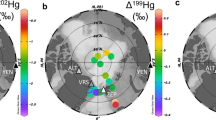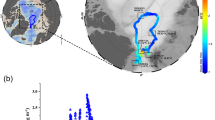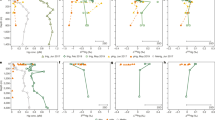Abstract
Methyl chloride (CH3Cl), the most abundant halocarbon in the atmosphere, has received much attention as a natural source of chlorine atoms in the stratosphere1,2. The annual global flux of CH3Cl has been estimated to be around 3.5 Tg on the grounds that this must balance the loss through reaction with OH radicals (which gives a lifetime for atmospheric CH3Cl of 1.5 yr)3,4,5. The most likely main source of methyl chloride has been thought to be oceanic emission2,6,7,8, with biomass burning the second largest source9. But recent seawater measurements10 indicate that oceanic fluxes cannot account for more than 12% of the estimated global flux of CH3Cl, raising the question of where the remainder comes from. Here we report evidence of significant CH3Cl emission from warm coastal land, particularly from tropical islands. This conclusion is based on a global monitoring study and spot measurements, which show enhancement of atmospheric CH3Cl in the tropics, a close correlation between CH3Cl concentrations and those of biogenic compounds emitted by terrestrial plants, and OH-linked seasonality of CH3Cl concentrations in middle and high latitudes. A strong, equatorially located source of this nature would explain why the distribution of CH3Cl is uniform between the Northern and Southern hemispheres, despite their differences in ocean and land area.
This is a preview of subscription content, access via your institution
Access options
Subscribe to this journal
Receive 51 print issues and online access
$199.00 per year
only $3.90 per issue
Buy this article
- Purchase on Springer Link
- Instant access to full article PDF
Prices may be subject to local taxes which are calculated during checkout




Similar content being viewed by others
References
Fabian, P. in The Handbook of Environmental Chemistry (ed. Hutzinger, O.) Vol. 4/Part A, 23–51 (Springer, Berlin, 1986).
Graedel, T. E. & Keene, W. C. The tropospheric budget of reactive chlorine. Glob. Biogeochem. Cycles 9, 47 –77 (1995).
Koppmann, R. et al. Distribution of methylchloride, dichloromethane, trichloroethene and tetrachloroethene over the North and South Atlantic. J. Geophys. Res. 98(D11), 20517–10526 (1993).
Logan, J. A. et al. Tropospheric chemistry: A global perspective. J. Geophys. Res. 86, 7210–7254 (1981).
Khalil, M. A. K. & Rasmussen, R. A. Atmospheric methyl chloride. Atmos. Environ. 33, 1305 –1321 (1999).
Rasmussen, R. A. et al. Concentration distribution of methyl chloride in the atmosphere. J. Geophys. Res. 85, 7350– 7356 (1980).
Singh, H. B., Salas, L. J. & Stiles, R. E. Methyl halides in and over the eastern Pacific (40° N–32° S). J. Geophys. Res. 88, 3684– 3690 (1983).
Cicerone, R. J. Halogens in the atmosphere. Rev. Geophys. Space Phys. 19, 123–139 (1981).
Blake, N. J. et al. Biomass burning emissions and vertical distribution of atmospheric methyl halides and other reduced carbon gases in the south Atlantic region. J. Geophys. Res. 101(D19), 24151– 24164 (1996).
Moore, R. M., Groszko, W. & Niven, S. J. Ocean-atmosphere exchange of methyl chloride: results from NW Atlantic and Pacific Ocean studies. J. Geophys. Res. 101, 28529–28539 (1996).
Yokouchi, Y. et al. Isoprene in the marine boundary layer (Southeast Asian Sea, Eastern Indian Ocean, Southern Ocean): comparison with DMS and bromoform. J. Geophys. Res. 101(D7), 8067– 8076 (1999).
Li, H.-J., Yokouchi, Y. & Akimoto, H. Measurements of methyl halides in the marine atmosphere. Atmos. Environ. 33, 1881– 1887 (1999).
Zimmerman, P. R. Testing of hydrocarbon emissions from vegetation, leaf litter and aquatic surfaces and development of a methodology for compiling biogenic emission inventories. (Report EPA-450/4-79-004, US Environmental Protection Agency, Research Triangle Park, North Carolina, 1979).
Yokouchi, Y. et al. Determination of monoterpene hydrocarbons in the atmosphere. J. Chromatogr. 209, 293– 298 (1981).
Harper, D. B. Halomethane from halide ion—a highly efficient fungal conversion of environmental significance. Nature 315, 55–57 (1985).
Attieh, J. M., Hanson, A. D. & Saini, H. S. Purification and characterization of a novel methyltransferase responsible for biosynthesis of halomethanes and methanethiol in rassica oleracea. J. Biol. Chem. 270, 9250– 9257 (1995).
Saini, H. S., Attieh, J. M. & Hanson, D. Biosynthesis of halomethanes and methanethiol by higher plants via a novel methyl transferase reaction. Plant Cell Environ. 18, 1027–1033 ( 1995).
Atlas, E. et al. Alkyl nitrates, nonmethane hydrocarbons, and halocarbon gases over the equatorial Pacific Ocean during saga 3. J. Geophys. Res. 98, 16933–16947 ( 1993).
Acknowledgements
We thank staff at the Atmospheric Environment Service station for assistance in sample collection at Alert. We are grateful to the National Institute of Polar Research, Japan for the opportunity to participate in the 39th Japanese Antarctic Research Expedition. We also thank the staff of the Global Environmental Forum Foundation for their assistance with sample collection at Hateruma and with the Skaugran cruise. In addition, we also thank the staff of the Environmental Management Center (Indonesia) for their assistance in the field study at Jakarta and Bandung. This work was supported in part by the Science and Technology Agency of Japan, by the Global Environment Fund (Environmental Agency of Japan), and by the Atmospheric Environment Service of Canada.
Author information
Authors and Affiliations
Corresponding author
Rights and permissions
About this article
Cite this article
Yokouchi, Y., Noijiri, Y., Barrie, L. et al. A strong source of methyl chloride to the atmosphere from tropical coastal land. Nature 403, 295–298 (2000). https://doi.org/10.1038/35002049
Issue Date:
DOI: https://doi.org/10.1038/35002049
This article is cited by
-
Emission estimates of methyl chloride from industrial sources in China based on high frequency atmospheric observations
Journal of Atmospheric Chemistry (2017)
-
Partial hydration of n-alkyl halides at the water–vapor interface: a molecular simulation study with atmospheric implications
Theoretical Chemistry Accounts (2014)
-
Hybrid NAA method for assessment of the levels of organic halogen compounds in the atmosphere in China
Journal of Radioanalytical and Nuclear Chemistry (2008)
-
Instrumental neutron activation analysis of extractable organohalogens in PM2.5 and PM10 in Beijing, China
Journal of Radioanalytical and Nuclear Chemistry (2007)
-
Strong emission of methyl chloride from tropical plants
Nature (2002)
Comments
By submitting a comment you agree to abide by our Terms and Community Guidelines. If you find something abusive or that does not comply with our terms or guidelines please flag it as inappropriate.



